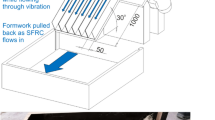Abstract
In steel fiber reinforced concrete (SFRC), the fibers are generally considered to be oriented isotropically. However, it is known that the procedures used in the specimen fabrication during quality control and material characterization may influence the distribution of the fibers significantly. This has an important effect on the properties determined from the specimens, which has to be considered when the results are used to analyze the behavior of other elements. In the present work, the orientation and segregation of fibers in cylindrical specimens and prisms, which are normally used in the mechanical characterization of SFRC, are evaluated. The type of compaction (i.e., table vibration, hand tamping and internal vibration) is seen to have a considerable influence on the distribution of the fibers. In the prisms, table vibration increases the tendency for the fibers to be oriented horizontally. In the cylindrical specimens, hand tamping appears to cause the least non-uniformity of the fiber distribution. The study was conducted on conventional concretes with 40 kg/m3 of fibers.
Résumé
Dans le béton armé avec des fibres d'acier (BAFA), les fibres sont généralement considérées comme étant orientées de manière isotropique. Toutefois, les procédures utilisées dans la fabrication d'échantillons peuvent influencer, de manière significative, la distribution des fibres. Elles jouent sur les propriétés mesurées sur les échantillons, un rôle important, qui doit être pris en compte lorsque les résultats sont utilisés pour analyser le comportement des autres éléments. Dans le présent travail, sont étudiées l'orientation et la ségrégation des fibres dans des échantillons cylindriques et prismatiques, lesquels sont généralement utilisés lors de la caractérisation des BAFA. Le type de compactage (c'est-à-dire, table vibrante, compactage manuel et vibration interne) est considéré comme ayant une influence considérable sur la distribution des fibres. Dans les prismes, la table vibrante crée la meilleure disposition pour l'alignement horizontal des fibres. Dans un échantillon cylindrique, le compactage manuel apparaît comme la cause de la non uniformité de la distribution des fibres. L'étude a été réalisée sur des bétons conventionnels ayant une densité de fibres de 40 kg/m3.
Similar content being viewed by others
References
Edgington, J. and Hannant, D.J., ‘Steel fibre reinforced concrete. The effect on fibre orientation of compaction by vibration’,Mater. Struct. 5 (25) (1972) 41–44.
Stroeven, P., ‘The analysis of fibre distributions in fibre reinforced materials’,J. Microscopy 111 (1977) 283–295.
Stroeven, P., ‘Morphometry of fibre reinforced cementitious materials, Part II: Inhomogeneity, segregation and anisometry of partially oriented fibre structures’,Mater. Struct. 12 (1979) 9–20.
Soroushian, P. and Lee, C.-D., ‘Distribution and orientation of fibers in steel fiber reinforced concrete’,ACI Mater. J. 87 (5) (1990) 433–439.
Toutanji, H. and Bayasi, Z., ‘Effect of manufacturing techniques on the flexural behaviour of steel fiber-reinforced concrete’,Cem. Concr. Res. 28 (1) (1998) 115–124.
Akkaya, Y., Picka, J. and Shah, S.P., ‘Spatial distribution of aligned short fibers in cement composites’,J. Mater. in Civil Engng. 12 (3) (2000) 272–279.
Swamy, R.N. and Stavrides, H., ‘Influence of the method of fabrication on strength properties of steel fibre concrete’,Mater. Struct. 9 (52) (1976) 243–253.
Delvasto, S., Naaman, E.A. and Throne, J.L., ‘Effect of pressure after casting on high strength fibre reinforced mortar’,Intnl. J. of Cem. Comp. and Lightweight Conc. 8 (3) (1986) 181–190.
Stroeven, P., ‘Effectiveness of steel wire reinforcement in a boundary layer of concrete’,Acta Stereol. 10/1 (1991) 113–122.
Author information
Authors and Affiliations
Additional information
Editorial note Dr. Ravindra Gettu is a RILEM Staff Member. He is the secretary of RILEM TC 187-SOC ‘Experimental determination of the stress-crack opening curve for concrete in tension’.
Rights and permissions
About this article
Cite this article
Gettu, R., Gardner, D.R., Saldívar, H. et al. Study of the distribution and orientation of fibers in SFRC specimens. Mat. Struct. 38, 31–37 (2005). https://doi.org/10.1007/BF02480572
Received:
Accepted:
Issue Date:
DOI: https://doi.org/10.1007/BF02480572




